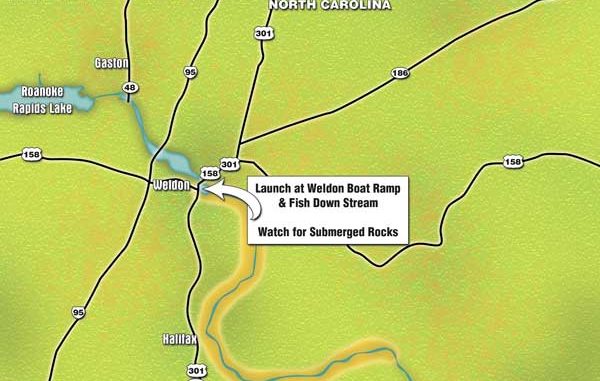
Expert, who no longer can use herring, have found other means to catch striped bass at this prime eastern river.
It was late afternoon with daylight growing dimmer by the minute. Most fishermen were busy loading boats onto trailers after spending a day along the Roanoke River.
One guide remained on the water after discharging his fishing party at the dock at the N.C. Wildlife Resources Commission Weldon Boating Access Area.
“Stripers bite best early and late in the day,” Capt. George Beckwith Jr. said. “Most people are leaving the river when they should just be getting started.”
The owner/operator of Down East Guide Service has a penchant for catching big fish. He fishes for tarpon and sailfish in Costa Rica during winter and cobia, tarpon and giant red drum each summer near Morehead City. Each spring he prospects the Roanoke River for giant striped bass.
During this 2006 striped bass fishing trip, river herring were his bait of choice. But a hitch was coming for Roanoke River anglers who preferred herring as striper baits. The WRC already had announced a ban on catching herring, scheduled to begin later in the year. These baitfish almost had been wiped out in North Carolina, so a moratorium on commercial netting and recreational uses of herring was on the horizon.
Beckwith was accustomed to using river herring, a collective term for alewife and blueback herring, to catch striped bass. The WRC ban allows a small commercial catch for scientific research purposes and cultural consumption during a few eastern N.C. herring festivals. But to commercial and sport fishermen, these prime striper baitfish soon would be contraband.
“People will have to get used to catching fewer big fish and 100- to 200-fish days,” Beckwith said. “But while it’s going to be tougher to land lots of big fish, the potential will still always be there for those willing to take on the challenge with other baits besides herring.”
Beckwith already was experimenting with other techniques for catching big striped bass during 2006 before the ban would begin. He used two methods for catching striped bass with artificial lures. One was fly-fishing with large flies; the other was casting giant jigs rigged with soft-plastic fluke-type trailers.
“When using artificial lures and fishing with them at the right times, anglers can still expect to catch 30 to 40 fish a day, with a couple of 20 to 30-pounders in the mix,” he said. “The fishing is especially good in April and May and the bigger fish usually show up in the Roanoke at Weldon around April 15, so we call them ‘tax fish.’
“When the fish are spawning, the females release their eggs and the males fertilize them, and it’s pretty wild. The fish boil the water — it’s called a ‘fish fight.’ When you see them making a commotion on the surface, you cast a big lure and try to draw an impulse strike.”
For drawing impulse strikes from spawning stripers, Beckwith uses several types of lures. But with all of them, he prefers a fast, erratic retrieve.
“A lot of lures will work when the stripers are showing on top,” he said. “I like using the 10-inch Yum Salt-injected soft fluke with an offset J-hook or an 8/0 octopus hook. I also use a Rapala Husky Jerk stickbait. I rig the Rapala by removing the treble hooks from the front and back of the lure and put a single long-shank No. 2 hook in the middle of the lure. I reel and twitch the lure, with a fast retrieve.”
Beckwith cruised the river in his boat, watching the water carefully. He was not only looking for fish and making sure his boat’s wake didn’t disturb the fishing of anchored anglers or those using trolling motors while casting along the narrow river channel, he was watching out for rocks — not the fish but the real kind that can destroy lower units of boats.
“If you don’t know the water, you have to be extremely careful of the rocks,” he said. “The river rises and falls so fast, there are places that are safe to navigate one day, but where you can tear up your motor the next day. If the water is low, there are lower units and fiberglass lost to the rocks. The best advice is to go slow and watch carefully.”
But the rocks also have positive aspects. Some formed islands in the middle of the river and others formed peninsulas. In eddies created by the flow disruptions, striped bass rested and waited for easy meals to float past them.
“I try to use big lures that imitate injured herring because that’s what these fish eat,” he said. “But to increase odds of catching fish, I also get away from the traffic.
“Most people stay closer to the ramp at Weldon, and you can’t safely go upstream of the U.S. 158 Bridge without a jet-drive motor or during high water conditions. There are too many rocks in the rapids just above the ramp. Anglers find fish near the ramp and are afraid of the rocks downstream. So I just keep going downstream until the boats thin out before I begin fishing.”
Beckwith saw a tree that had fallen tightly against the bank, so he cast into the break in the current. Instantly, a big fish attacked a herring, which still were legal to use as bait. He used bait-casting tackle to land the big fish after a hard fight.
These days, Beckwith still uses live baits when he can get them. But since they are more scarce and don’t work as well as herring, he is selective about the locations where he uses them.
“When we could use herring, we found out the big fish concentrate together. If you get a hit and a miss from a big striper, there’d be more fish there. Stripers move from year to year and day to day as they migrate and stage up and down the river.
“Ledges, trees that have fallen into the water, drop-offs and other similar places may hold big fish. Usually, its going to be a place where there were no fish yesterday or a place that looks just like any other spot, but there could be a lot of big fish hanging there.”
Beckwith said stripers seek cover from the sun and boats during the day. Boat wakes create mud lines near the banks that help fish hide.
“The bite moves to where there’s less boat traffic and more shade during the day,” he said. “You might have to flip a big bait or lure right into the bushes to catch them. I like a pig-n-jig with a weed guard. White is a good color. Bass fishing tactics work well when the fish are in the bushes.
“We discovered watching shocking boats how many fish can be in one spot. They would go along and shock up tons of small fish, weighing 2 to 4 pounds. Then they’d roll up 20 stripers weighing more than 20 pounds. There could be 200 big fish in one spot.”
Rather than herring, which he used to jig from the river with Sabiki rigs, Beckwith now uses eels, which he buys from bait-and-tackle shops, or shad, which he catches from lakes upstream.
“The smaller shad species don’t work as well as gizzard shad,” he said. “A gizzard shad makes an excellent big-fish bait if you slice it into a long strip bait leaving the head and guts intact.
“With eels, you can fish them alive and whole or by cutting them into sections. Put them on a light line with a single hook or on a bottom rig and cast them to the places where you just had a strike with an artificial lure from a big fish and you’re likely to catch another big fish.
“Eels and shad are expensive, costing $3 to $4 apiece during the peak of the striper run. It takes time to catch shad in a cast net and transport them to the river, so you don’t want to just start using them anywhere. There are lots of little stripers in the river that will steal your big-fish baits.”
Beckwith said some anglers use panfish for striper bait. They use worms, crickets or small spinnerbaits to catch them and put them in live wells. But Beckwith said that pursuit for baits burns time he could use better by fishing for stripers.
The fish bit well until it was dark, then Beckwith headed to the ramp. The next day at dawn, Capt. Greg Voliva of Down East Guide Service was at the Weldon ramp. His father, Carroll, and brother, Dan, accompanied him.
“I’ve never fished with Greg or caught a striper,” Carroll Voliva said. “I want to see what the excitement is about.”
After Greg Voliva became a fishing guide, his father and brother hadn’t fished for stripers with him, nor had they ever caught a rockfish. With the family aboard, the center console boat took off downriver.
Greg Voliva, like Beckwith had done the day before, was using live herring, which were legal baits at the time.
His father and brother quickly caught several huge stripers by casting them to holes where Voliva had found the fish the previous day.
The guide agreed with Beckwith’s revised striper tactics under the herring-bait ban.
“I want to target the bigger fish during the spawn,” Voliva said. “I like using the bigger soft-plastic jerk-style baits — the split-tail flukes and paddle tails.
“The big spawning fish could show up in late April, but they usually peak during the second week in May. I fish early and late in the day and use the big soft plastics like a topwater lure.
“You have to watch for places where you see signs of big fish and cast to those spots. It helps by targeting the big splashes because there are so many more small fish in the river than big ones. If you want big fish, you can’t waste your time with the small fish.”
After catching several big fish with herring, the anglers decided to try another spot and switch to artificial lures. They found large numbers of fish within sight of the Weldon ramp, near the U.S. 158 Bridge.
While his father and brother cast jigs with soft plastic trailers into the whitewater below some rocks, Greg Voliva used a fly rod to catch stripers.
“I use an 8-weight rod for stripers,” he said. “The line is a 250- or 300-grain sinking 8-weight line. I use a nail knot to tie a loop of fluorocarbon at the end of the fly line and then a loop-to-loop connection to tie a 12-inch section of 40-pound fluorocarbon leader to the line. I use a Bimini twist to tie a 2- to 3-foot section of 15-pound fluorocarbon to the 40-pound fluorocarbon and tie the fly directly to the leader.”
The sinktip line took the fly down to the bottom in the strong current. Stripers were striking the fly regularly.
“It’s something different to try when there are lots of small fish in the river,” he said. “A striper will hit any fly. But I like the Clouser and Half-and-Half. You cast it and let it sink then strip it fast with short strips. He’ll come up off the bottom and strike it; sometimes he’ll strike it as you lift it from the water.”
Everyone was catching stripers, even anglers fishing from the bank.
“It’s exciting to catch so many fish,” Carroll Voliva said. “Now I see why Greg likes doing this for a living.”
“It’s awesome catching so many fish,” Dan Voliva said. “I’ve never caught any fish as big as we did today.”
Teenagers were casting from the rocks near the shoreline and having better luck than many anglers fishing from boats anchored in the river channel.
Beckwith’s words as he pulled his boat from the water in the dark the previous evening proved prophetic. He said it was no wonder the ramp could get so crowded at times he had to launch before daylight and haul out after dark.
“When the striper bite’s on at the Roanoke, you should bring any trout grubs you tried but don’t like,” he said. “Bring any fly you have and give it a try.
“Use those old lures you don’t want fish anymore because there are so many aggressive fish, if it won’t catch one here, it won’t catch fish anywhere.
“You can toss a lure that doesn’t catch a Roanoke striper in the trash and walk away with a clean conscience.”

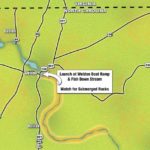

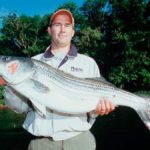
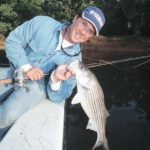
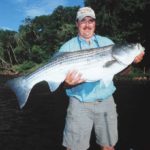
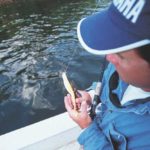
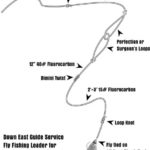



Be the first to comment